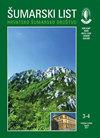Relationship of silver fir (Abies alba Mill.) mortality in the area of Fužine with climatic and structural parameters
IF 0.4
4区 农林科学
Q4 FORESTRY
引用次数: 0
Abstract
Tree dieback is a complex process involving negative impact of various abiotic, biotic and anthropogenic factors. Climate change, comprising all those effects, is generally considered as the largest threat to forest ecosystems in Europe. Although the scale of climate change impacts on forests is not yet fully understood, especially on the regional or species level, significant damage seems to be caused by weather extremes, such as drought and strong winds. With the expected increase in the number, length, and/or intensity of extreme weather events in Croatia, research into the causes of tree mortality is both important and timely. Silver fir is the most damaged and endangered conifer tree species in Croatia. The dieback of silver fir can be attributed to various factors, therefore the goals of this research were to determine the mortality of silver fir trees (by number and volume) for various causes of mortality, among which the climatic and structural parameters were of most interest. The twenty-year data for tree mortality in pure silver fir stands in the area of Fužine (Gorski kotar, Croatia) were collected and analysed. The largest number and volume of dead trees was caused by complex (multiple causes) dieback in the overstorey (0,75 N/ha, 2,35 m3/ha), and the smallest (0,17 N/ha, 0,02 m3/ha) by dieback of supressed trees. No significant differences were determined regarding the timing of tree death for different causes of mortality. Climatic parameters (drought, air temperature, PET) and structural parameters of the stands (tree DBH, social position, crown diameter, shading, physiological maturity) as well as plot inclination were found to be the factors of a significant influence on the mortality of silver fir trees.Fužine地区银杉(Abies alba Mill.)死亡率与气候和结构参数的关系
树木枯死是一个复杂的过程,涉及各种非生物、生物和人为因素的负面影响。气候变化,包括所有这些影响,通常被认为是对欧洲森林生态系统的最大威胁。虽然气候变化对森林影响的规模尚未完全了解,特别是在区域或物种水平上,但干旱和强风等极端天气似乎造成了重大破坏。随着克罗地亚极端天气事件的数量、长度和/或强度预计会增加,对树木死亡原因的研究既重要又及时。银杉是克罗地亚受损最严重和濒危的针叶树。银杉枯死可归因于多种因素,因此本研究的目的是确定各种死亡原因下银杉树木的死亡率(按数量和体积),其中气候和结构参数最令人感兴趣。收集和分析了Fužine(克罗地亚Gorski kotar)地区纯银冷杉林20年来的树木死亡率数据。枯死数量和枯死体积最大的原因是上层复杂(多原因)的枯死(0.75 N/ha、2.35 m3/ha),最小的原因是被抑制树木的枯死(0.17 N/ha、0.02 m3/ha)。不同死亡原因的树木死亡时间没有显著差异。气候参数(干旱、气温、PET)、林分结构参数(胸径、社会地位、冠径、遮荫、生理成熟度)和样地倾斜度是影响银杉死亡率的重要因素。
本文章由计算机程序翻译,如有差异,请以英文原文为准。
求助全文
约1分钟内获得全文
求助全文
来源期刊

Sumarski List
FORESTRY-
CiteScore
0.90
自引率
20.00%
发文量
32
审稿时长
>12 weeks
期刊介绍:
Forestry Journal publishes scientific and specialist articles from the fields of forestry, forestry-related scientific branches, nature protection and wildlife management.
 求助内容:
求助内容: 应助结果提醒方式:
应助结果提醒方式:


